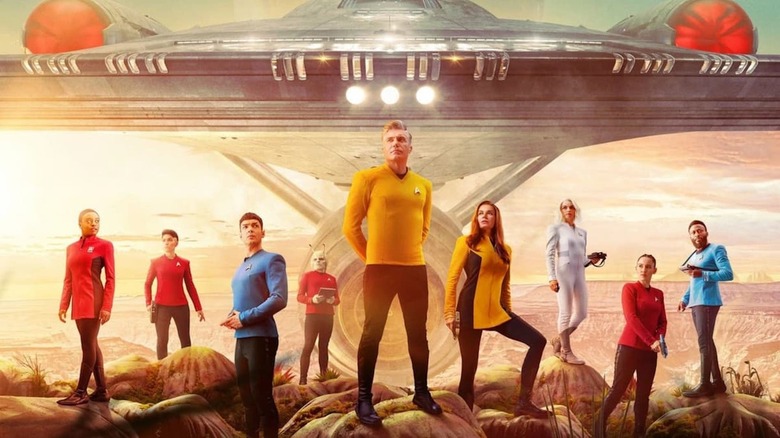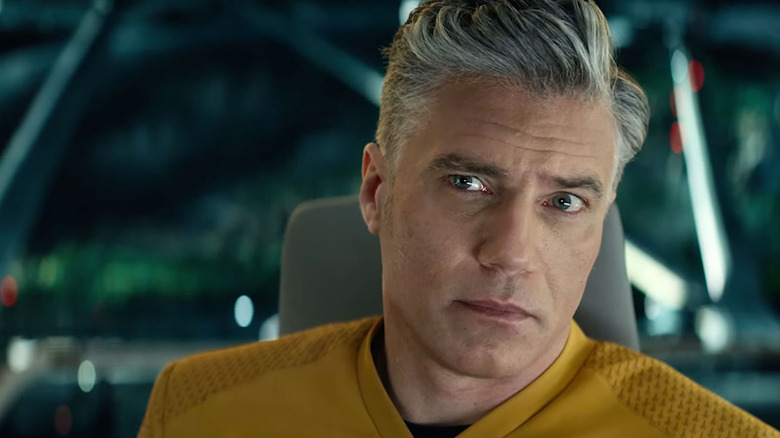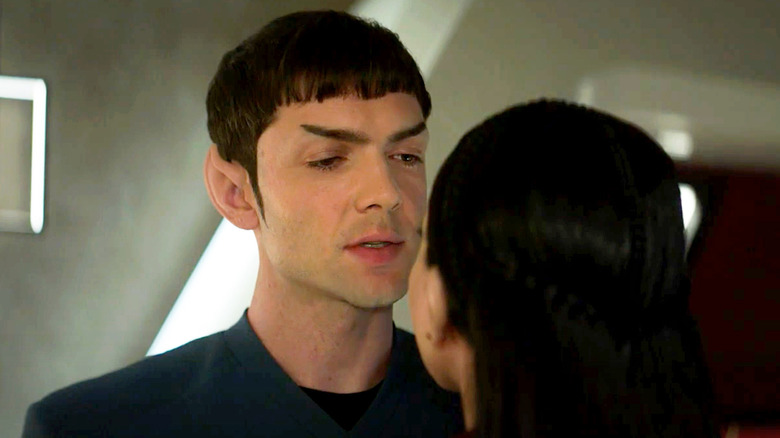Star Trek: Strange New Worlds Showrunner On Reinventing A Classic Villain And Letting Spock Be Sexy [Interview]
"Star Trek: Strange New Worlds" is a breath of fresh air. The episodic, optimistic, and yes, even sexy new series is both a throwback to classic "Trek" and a bold swing at something different. It's the live-action "Star Trek" show fans have been waiting for, and also a perfect jumping-on point for new viewers wondering what the fuss is all about. It loves franchise history (The Easter eggs! The in-jokes!), but it stands on its own, ready to transform a legion of newbies into die-hard Trekkies. The five episodes provided to critics represent, quite frankly, the best live-action "Star Trek" television since the '90s.
At the helm of the series is co-showrunner Akiva Goldsman (working alongside co-showrunner Henry Alonso Myers), who is no stranger to "Star Trek." Goldsman has been an active presence throughout the franchise's modern era, but "Strange New Worlds" is a very different beast from "Star Trek: Discovery" and "Star Trek: Picard," which are very dark, heavily serialized shows. With its hopeful themes, colorful characters, and one-and-done adventure storytelling, "Strange New Worlds" offers a tricky balancing actor for Goldsman and his team — win over even the most jaded of "Trek" fans while making something that'll stand out in the ever-crowded streaming space. They succeeded.
I recently spoke with Goldsman over the phone about working on the series, creating a new backstory for legacy characters, reinventing iconic villains, and yes, knowing damn well people want to see Spock with his shirt off. Note: there are no spoilers in this conversation, but we do discuss vague elements of episodes that will air in the weeks ahead.
'I will take it as high praise if we leave people feeling hopeful, connected, and good'
"Strange New Worlds" is a comforting show. I felt really, really good after watching it.
Thank you. I appreciate that.
Is this what you wanted people to feel? Like they had a warm hug or a good meal?
Well, I mean, sure. I think that more than anything else, what we wanted to do was contemporize or make contemporary the feelings that a bunch of us had when we first saw "Star Trek" when we were young. Certainly, I know in my case, I'm pushing 60 this July. So in my case, when I was watching it, I suppose I was 11 or 12 when it was first on syndication, it made me feel comforted. It's the right word. I felt out of place and not quite connected to the world. And yet here was this place where it felt like I belonged. And so I think that is a form of comfort, and I will take it as high praise if we leave people feeling hopeful, connected, and good.
And a lot has been said about the episodic nature of the show and return to one-off stories. Did you and your writing team have to relearn how to tell these sort of contained stories after years of TV pivoting to serialization?
I think that, interestingly enough, really closed-ended storytelling is a muscle we all developed first, right? We probably had to really learn open-ended storytelling. And open-ended storytelling or serialized storytelling is really just a big version of closed storytelling, but it's where the breakpoints are that becomes a little bit more negotiated between yourself and your keyboard and your peers. But this is an older muscle and by the way, after several seasons of various episodic forays, quite a pleasure.
Did you feel pressure about creating backstories for characters like Dr. M'Benga, Number One, and Nurse Chapel, who have existed in our personal headcanon for decades?
There are very few things where I can say this with some level of confidence, but I'm just not that different from a lot of other people who watched "Star Trek" when they were younger. So I probably have about as much headcanon on M'Benga as most folks, and as Number One, and I'm not a person who's super-saturated in the novelizations, or the novels, or even the extended universe per se. You know? So I live very much as a hopefully pretty faithful representative of, "Huh, I wonder whatever happened to that guy?" Which is about where Dr. M'Benga lived for most of us. Wow. He was cool. How come he was only in two [episodes]. Do you know what I mean?
Yeah.
Oh, wow. Wasn't Number One really interesting? Look, she was like Spock. You know what I mean? If you really just kind of feed off of what from having loved it, you feel relatively safe, not entirely screwing it up.
I want to talk about the new uniforms. When I spoke to [Number One actress] Rebecca Romijn at the press junket, she talked about how she really wanted to make the dress uniform happen, and how it ultimately led to everybody having multiple outfits and alternate uniforms. Can you talk about that?
Well, I think what we ended up doing was realizing that people have closets, right? And that you actually have to ... People wear more than one thing. I'm not sure if by episode five Jim's green tunic has shown up yet ...
I laughed in recognition. I was very pleased.
Good. For me, that was like, let's dust that idea off, despite what its actual intentions or its actual reasoning for its existence may have been in season 2 of the original show. And let's talk about a variety of style. You know? And then the other thing that I don't know if Rebecca told you, but that really came from this, which was amazing and fun, is ... so that short skirt tunic is unisex. So we actually have men walking around in a short skirt, too.
'I have this long standing love for the Gorn'
I'll ask this broadly so you can approach it how you want to. There is a classic, but also extremely under-explored Trek villain in the first five episodes who is reinvented as a genuinely terrifying force. Are you able to talk about them?
Yeah. I'm happy to talk about the Gorn. I mean, I'm a little Gorn-obsessed. You'll notice actually, as Easter eggs within Easter eggs go, at the Lorca's lab in "Star Trek: Discovery," there's an unlabeled Gorn skeleton. And [former "Star Trek: Picard" showrunner] Michael Chabon and I almost had a dayglo Gorn painting in the commissary on the Borg cube.
I have this long-standing love for the Gorn. And when I say love, fascination really is the right word, because I think that one thing that "Star Trek" does great is it generates empathy. It's part of what we do in "Star Trek." And we sort of want to cross the divide, and we use the divide between species as a metaphor [for] the divide between people. But sometimes what gets lost is the possibility of evil, which is also something that I think exists. And so I've yearned a little bit for an enemy who is just that, at least to begin with. And it's been a while since we've had that, and the Gorn sort of presented themselves as such. So off we go.
The /Film team has already started shipping the cast of Strange New Worlds. We've talked about how any pairing of any characters has possible romantic chemistry. Is this something you were aware of in the writers' room?
[noticeably thrilled] No! This is the greatest thing I've ever heard. Tell me.
We've talked about Chapel and Dr. M'Benga. Spock and Pike. Spock and everyone, really.
That's fantastic. I mean, there are some pairings coming, certainly, but I can't say who.
Speaking of which, after decades of Spock being the thinking person's sex symbol, to see Spock actually treated that way in the show was wonderful.
I'm glad. It was really fun. I got to direct that first episode, and [Spock actor Ethan Peck] was like, "What? No shirt?" And then suddenly, yeah, no shirt. I mean he's very, very, he's beautiful as well as being such a compelling actor. And part of what we're doing here ... I'm not the first to say this season. I said this before, but I'm always pretty fascinated [by] what we refer to internally as "smiley Spock," which is yellow-shirted, "Where No Man Has Gone Before" Spock [referring to the second pilot of the original "Star Trek" series]. I'm interested in who that guy was. Because I think Spock's life, if you think about it, we always go logical, logical, logical. But if you really look at it, I mean, you can go to "Star Trek: Motion Picture," it's been a waveform of logic, emotion. So we always see him in the emotion-tamped-down part, but that suggests that there were times when it came through in a way that's more wholesome. And I think we'll be looking at that.
The episode that sealed the deal for me was the shore leave episode [episode 5 of the season]. The franchise's willingness to embrace comedy has always been a strength and I think there's always room for laughter in "Star Trek."
Yeah. You bet. I mean, I think that one thing that we get to do with episodic, which we didn't get to do with serialized except little grace notes, is to it to vary tone the way the original series did. And so you do have these episodes where you can embrace a submarine thriller, like you've seen, or straight horror, you haven't seen yet. Or as you say, a shore leave episode, where we can be funny. We can embrace other tones and our show is strong enough to explore them and deliver character and entertainment as we sort of move somewhat through genre.
"Star Trek: Strange New Worlds" is currently streaming on Paramount+.


